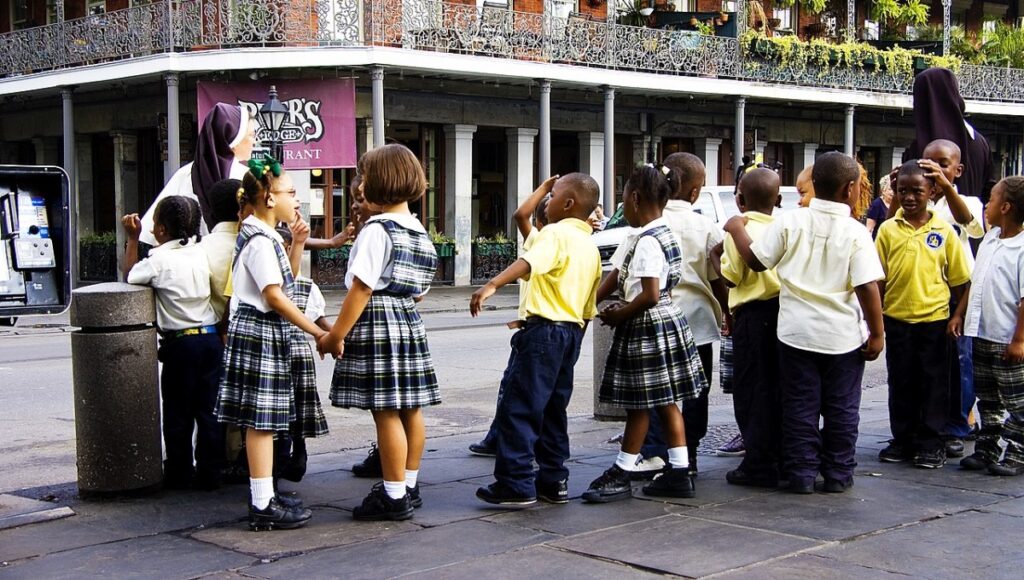Originally Authored at TheFederalist.com

As innovation constantly transforms nearly every area of life, schooling has remained remarkably consistent in the last century — until recently. This has left parents, teachers, and policymakers grappling with what “school” means today. Catholics must also consider this if we want to ensure a firm foundation for the future.
The Catholic school system in America represents an amazing historic achievement. Bishops and pastors from the mid-1800s to the mid-1900s were very focused on building schools to ensure the United States’s growing Catholic population could be educated in the faith — and kept out of public schools that were often anti-Catholic. Even after shrinking considerably from its peak in the 1960s, it remains the largest non-governmental school system in the country and possibly the world.
But the parish school is not the only way to deliver Catholic education, just as an assigned public school is not the only way to deliver non-Catholic education. The educational landscape has undergone a dramatic transformation. These changes have been happening somewhat quietly for decades, most markedly with the growth of homeschooling.
Covid-19 closures accelerated this dynamic as parents got to test-drive home education and had a front-row seat into what their kids were being taught. Many parents decided they wanted to take more control of their children’s education. Lawmakers — especially in “red” states — responded by passing or expanding school choice programs, such as vouchers for private school tuition or education savings accounts that can be used for a variety of educational purposes.
The combination of more interest from parents and the availability of scholarships has helped prompt new learning options. Microschools, intentionally small schools that typically focus on individualized education, and hybrid schools, which combine in-person and at-home learning, existed pre-lockdowns. Still, most parents — and teachers — had never heard of them. It’s impossible to know precisely how many students are using these options because many states don’t track such data, but there has been an increase in recent years.
Catholic schools, meanwhile, are facing tough times. Enrollment peaked in the mid-1960s with around 5.7 million students in nearly 13,500 Catholic schools — and thousands more students were turned away due to lack of space. A variety of issues, such as teacher shortages, rising costs, lack of space, changing demographics, and the sex abuse scandal resulted in a sharp decrease in enrollment after that high point. Today, approximately 1.7 million pre-K-12th grade students are enrolled at 5,900 Catholic schools.
There are still reasons to be optimistic about Catholic education. While enrollment dropped during lockdowns, some Catholic schools’ choice to stay open when many public schools were closed resulted in an uptick in enrollment. Data from the National Catholic Educational Association (NCEA) indicates enrollment has been holding relatively steady since then, although it hasn’t returned to pre-lockdown levels.
Even more encouragingly, Catholic schools in Florida, which promotes a robust school choice environment, have been growing. Over the past decade, enrollment has increased by 9 percent in Florida Catholic schools compared to an overall decrease in Catholic school enrollment nationwide during that time.
This has happened despite a competitive education market in Florida, partly because Catholic schools have developed innovative ways to better serve students and families. Catholic leaders in other states — especially states that have also adopted school choice — should look to Florida for ways to educate families about scholarship opportunities and ensure Catholic schools are rising to the challenge, thus providing a reason for families to choose them.
We also need to broaden our definition of “Catholic school” beyond just the traditional parish or diocesan school. According to estimates from the Census Bureau and the National Homeschool Education Research Institute, there are more than 3 million homeschoolers in the United States. The Pillar estimates there are upwards of 400,000 Catholic homeschoolers. An unknown number of students attend independent schools, including microschools and hybrid schools that are faithful to Catholic teaching but not supported by a parish or diocese.
Surveys show parents want these flexible, less-conventional educational options. Catholic parishes and schools are well-positioned to meet families’ changing needs by welcoming new educational providers into underutilized classrooms. While these options typically start small, they often grow as excitement spreads. But even if they remain small, they can have a powerful influence.
Driving past a shuttered Catholic church or school is heartbreaking. By embracing newer options like microschools, hybrid schools, and homeschool co-ops, church leaders can provide families with nimble, low-cost access to Catholic education. The spread of diverse learning models rooted in Catholic teaching can help revitalize the faith life of families, parishes, and the broader community.
Colleen Hroncich is a policy analyst at the Cato Institute’s Center for Educational Freedom.
